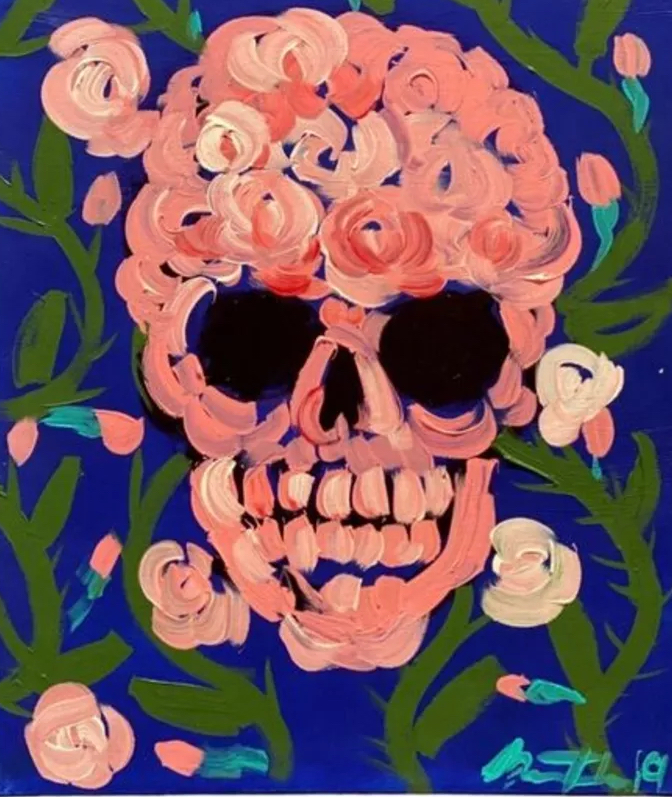
Bradley Theodore, a New York-based contemporary artist, is widely recognized for his vibrant, emotive, and symbolic work that often explores themes of identity, mortality, and cultural icons. His piece Little Skull on Blue (2019) is no exception, offering a striking visual experience that captures his signature style while inviting deep introspection. Known for his colorful skeletal figures and street art influences, Theodore uses Little Skull on Blue as a canvas to explore the fragility of life, the universality of human experience, and the interplay between light and darkness.
The Artist: Bradley Theodore
Born in Turks and Caicos and raised in New York City, Bradley Theodore’s artistic journey has been anything but conventional. Initially a digital and graphic artist, Theodore transitioned to fine art and street art, blending his experiences to create a style that is uniquely his own. His work often draws inspiration from the vibrant colors of his Caribbean heritage, combined with the gritty energy of New York City’s urban art scene.
Theodore’s art frequently explores the intersection of life and death, individuality and universality, and the ephemeral nature of fame and beauty. His iconic use of skeletal figures—often rendered in bright, bold colors—challenges traditional notions of mortality, turning what might be a macabre subject into something celebratory and life-affirming.
Visual Elements of Little Skull on Blue
Little Skull on Blue features a single skull, painted in Theodore’s trademark style, set against a rich, cobalt-blue background. The skull is constructed from expressive, painterly strokes of vibrant colors—pink, yellow, green, orange, and white—giving it a dynamic, almost three-dimensional quality. These colors contrast sharply with the serene, monochromatic blue backdrop, creating a powerful visual tension that draws the viewer’s attention to the skull.
The brushstrokes are loose and energetic, reflecting Theodore’s intuitive, almost improvisational approach to painting. This technique gives the piece a sense of motion and vitality, as if the skull itself is alive or in the process of transformation. The deliberate imperfections in the strokes suggest an underlying human presence, emphasizing the hand of the artist and the individuality of the subject.
The skull’s design is both anatomically recognizable and abstract, blending realism with stylization. It embodies a universal symbol of mortality while remaining uniquely Theodore’s creation, marked by his signature color palette and painterly technique.
Symbolism and Themes
Mortality and Universality
The skull has long been a symbol of mortality in art, serving as a memento mori—Latin for “remember that you must die.” In Little Skull on Blue, Theodore reinterprets this classic symbol in a way that feels vibrant and contemporary. The use of bright colors transforms the skull from a reminder of death into a celebration of life, suggesting that mortality is not something to be feared but embraced as part of the human experience.
By rendering the skull in such a universally appealing style, Theodore bridges cultural and historical boundaries, reminding viewers of the shared nature of human existence. The skull becomes a unifying symbol, stripped of individual identity yet rich with collective meaning.
The Interplay of Light and Darkness
The blue background in Little Skull on Blue plays a critical role in the piece’s thematic resonance. Blue often symbolizes calmness, introspection, and infinity, creating a stark contrast to the skull’s vivid, almost chaotic palette. This interplay suggests the duality of life and death, light and darkness, and joy and sorrow. The piece invites viewers to reflect on the balance between these opposing forces, which are central to the human condition.
Identity and Transformation
The abstract, painterly strokes that compose the skull suggest a sense of fluidity and transformation. Rather than being fixed or static, the skull seems to be in a state of becoming, reflecting Theodore’s belief in the ever-changing nature of identity and existence. This aligns with his broader body of work, which often explores themes of self-expression, reinvention, and the passage of time.
Context within Bradley Theodore’s Body of Work
Little Skull on Blue is part of Theodore’s ongoing exploration of skeletal imagery, a recurring motif in his art. While his earlier works often depicted celebrity icons—such as Frida Kahlo, Karl Lagerfeld, and Anna Wintour—in skeletal form, Little Skull on Blue shifts the focus to a more universal subject. This transition reflects Theodore’s growing interest in themes that transcend individual identity, addressing broader questions about humanity and existence.
The piece also showcases Theodore’s mastery of color and texture, hallmarks of his style. His use of vibrant, almost fluorescent hues has drawn comparisons to street art and pop art, while his painterly technique recalls the expressionism of artists like Jean-Michel Basquiat. These influences are evident in Little Skull on Blue, which combines the immediacy of graffiti with the depth and complexity of fine art.
Cultural and Artistic Significance
Little Skull on Blue holds a unique place within contemporary art, as it exemplifies the way artists are reinterpreting traditional symbols in a modern context. The skull, a motif that dates back to Renaissance vanitas paintings, has been reimagined by Theodore as a symbol of resilience, creativity, and interconnectedness. In doing so, he challenges viewers to rethink their relationship with mortality and the fleeting nature of life.
The piece also speaks to the democratization of art in the 21st century. Theodore’s background in street art and his use of vibrant, accessible imagery make his work relatable to a wide audience, bridging the gap between high art and popular culture. Little Skull on Blue is a testament to Theodore’s ability to create art that resonates on multiple levels, appealing to both casual viewers and serious collectors.
Reception and Impact
Since its creation in 2019, Little Skull on Blue has been widely celebrated for its bold aesthetic and emotional depth. Critics have praised Theodore’s ability to infuse a universal symbol with fresh meaning, while audiences have connected with the piece’s vibrant energy and uplifting message. The artwork has been featured in exhibitions and collections around the world, solidifying Theodore’s reputation as one of the most exciting voices in contemporary art.
The piece has also contributed to broader conversations about the role of art in addressing themes of mortality, identity, and cultural heritage. By combining traditional symbolism with a modern, multicultural perspective, Theodore has created a work that feels both timeless and timely.
Impression
Little Skull on Blue (2019) by Bradley Theodore is a masterful example of how contemporary artists are reinventing traditional motifs to address universal themes. Through its vibrant colors, dynamic composition, and rich symbolism, the piece invites viewers to reflect on the interconnectedness of life and death, the fluidity of identity, and the beauty of impermanence.
As part of Theodore’s broader body of work, Little Skull on Blue exemplifies his ability to blend fine art, street art, and cultural commentary into a cohesive and compelling vision. It stands as a testament to the power of art to transcend boundaries, challenge perceptions, and inspire new ways of thinking about the human experience. Whether viewed as a celebration of life, a meditation on mortality, or a fusion of past and present, Little Skull on Blue continues to captivate and resonate with audiences worldwide.
No comments yet.








